1234567891011121314151617181920212223242526272829303132333435363738394041424344454647484950515253545556575859606162636465666768697071727374757677787980818283848586
#include <bits/stdc++.h>
using namespace std;
class Solution {
public:
/* Function to find the shortest distance of all
the vertices from the source vertex S. */
vector <int> dijkstra(int V, vector<vector<int>> adj[],
int S) {
// Set to store {dist, node}
set <pair<int,int>> st;
// Distance array
vector<int> dist(V, 1e9);
// Distance of source node from itself is 0
dist[S] = 0;
// Adding the source node to set
st.insert({0, S});
// Until the set is empty
while(!st.empty()) {
// Get the distance
int dis = st.begin()->first;
// Get the node
int node = st.begin()->second;
st.erase(st.begin());
// Traverse all its neighbors
for(auto it : adj[node]) {
int adjNode = it[0]; // node
int edgeWt = it[1]; // edge weight
/* If the tentative distance to
reach adjacent node is smaller
than the known distance */
if(dis + edgeWt < dist[adjNode]) {
/* If another longer known distance
is found, erase it from the set */
if(dist[adjNode] != 1e9)
st.erase({dist[adjNode] , adjNode});
// Update the known distance
dist[adjNode] = dis + edgeWt;
// Add the new pair to the set
st.insert({dist[adjNode] , adjNode});
}
}
}
// Return the result
return dist;
}
};
int main() {
int V = 2, S = 0;
vector<vector<int>> adj[V] =
{
{{1, 9}},
{{0, 9}}
};
/* Creating an instance of
Solution class */
Solution sol;
/* Function call to find the shortest distance
of each node from the source node */
vector<int> ans = sol.dijkstra(V, adj, S);
// Output
cout << "The shortest distance of nodes from the source node is: ";
for(int i=0; i < V; i++) {
cout << ans[i] << " ";
}
return 0;
}
12345678910111213141516171819202122232425262728293031323334353637383940414243444546474849505152535455565758596061626364656667686970717273747576777879808182838485
import java.util.*;
class Solution {
public int[] dijkstra(int V, ArrayList<ArrayList<ArrayList<Integer>>> adj, int S) {
// TreeSet to store {dist, node}
TreeSet<int[]> set = new TreeSet<>((a, b) -> {
if (a[0] != b[0]) return Integer.compare(a[0], b[0]); // Compare by distance
return Integer.compare(a[1], b[1]); // If distances are equal, compare by node
});
// Distance array
int[] dist = new int[V];
Arrays.fill(dist, (int)1e9);
// Distance of source node from itself is 0
dist[S] = 0;
// Adding the source node to the set
set.add(new int[]{0, S});
// Until the set is empty
while (!set.isEmpty()) {
// Get the pair with the smallest distance
int[] current = set.pollFirst();
int dis = current[0];
int node = current[1];
// Traverse all its neighbors
for (ArrayList<Integer> neighbor : adj.get(node)) {
int adjNode = neighbor.get(0); // adjacent node
int edgeWt = neighbor.get(1); // edge weight
/* If the tentative distance to
reach adjacent node is smaller
than the known distance */
if (dis + edgeWt < dist[adjNode]) {
/* If another longer known distance
is found, erase it from the set */
set.remove(new int[]{dist[adjNode], adjNode});
// Update the known distance
dist[adjNode] = dis + edgeWt;
// Add the new pair to the set
set.add(new int[]{dist[adjNode], adjNode});
}
}
}
// Return the result
return dist;
}
}
class Main {
public static void main(String[] args) {
int V = 2, S = 0;
ArrayList<ArrayList<ArrayList<Integer>>> adj = new ArrayList<>();
// Adjacency list for the graph
for (int i = 0; i < V; i++) {
adj.add(new ArrayList<>());
}
adj.get(0).add(new ArrayList<>(Arrays.asList(1, 9)));
adj.get(1).add(new ArrayList<>(Arrays.asList(0, 9)));
// Creating an instance of Solution class
Solution sol = new Solution();
/* Function call to find the shortest distance
of each node from the source node */
int[] ans = sol.dijkstra(V, adj, S);
// Output
System.out.println("The shortest distance of nodes from the source node is: ");
for (int i : ans) {
System.out.print(i + " ");
}
}
}
12345678910111213141516171819202122232425262728293031323334353637383940414243444546474849505152535455565758596061626364
import heapq
class Solution:
# Function to find the shortest distance of all
# the vertices from the source vertex S.
def dijkstra(self, V, adj, S):
# Min-heap to store {dist, node}
st = []
# Distance array
dist = [int(1e9)] * V
# Distance of source node from itself is 0
dist[S] = 0
# Adding the source node to heap
heapq.heappush(st, (0, S))
# Until the heap is empty
while st:
# Get the distance
dis, node = heapq.heappop(st)
# Traverse all its neighbors
for it in adj[node]:
adjNode, edgeWt = it # node, edge weight
# If the tentative distance to
# reach adjacent node is smaller
# than the known distance
if dis + edgeWt < dist[adjNode]:
# Update the known distance
dist[adjNode] = dis + edgeWt
# Add the new pair to the heap
heapq.heappush(st, (dist[adjNode], adjNode))
# Return the result
return dist
# Main function
if __name__ == "__main__":
V = 2
S = 0
adj = [
[(1, 9)],
[(0, 9)]
]
# Creating an instance of
# Solution class
sol = Solution()
# Function call to find the shortest distance
# of each node from the source node
ans = sol.dijkstra(V, adj, S)
# Output
print("The shortest distance of nodes from the source node is: ", end="")
for i in range(V):
print(ans[i], end=" ")
12345678910111213141516171819202122232425262728293031323334353637383940414243444546474849505152535455565758596061626364656667686970717273747576
class Solution {
/* Function to find the shortest distance of all
the vertices from the source vertex S. */
dijkstra(V, adj, S) {
// Set to store {dist, node}
let st = new Set();
// Distance array
let dist = Array(V).fill(1e9);
// Distance of source node from itself is 0
dist[S] = 0;
// Adding the source node to set
st.add([0, S]);
// Until the set is empty
while (st.size) {
// Get the distance
let [dis, node] = [...st][0];
st.delete([...st][0]);
// Traverse all its neighbors
for (let it of adj[node]) {
let adjNode = it[0]; // node
let edgeWt = it[1]; // edge weight
// If the tentative distance to
// reach adjacent node is smaller
// than the known distance
if (dis + edgeWt < dist[adjNode]) {
// If another longer known distance
// is found, erase it from the set
if (dist[adjNode] !== Infinity)
st.delete([dist[adjNode], adjNode]);
// Update the known distance
dist[adjNode] = dis + edgeWt;
// Add the new pair to the set
st.add([dist[adjNode], adjNode]);
}
}
}
// Return the result
return dist;
}
}
// Main function
const main = () => {
let V = 2, S = 0;
let adj = [
[[1, 9]],
[[0, 9]]
];
// Creating an instance of
// Solution class
let sol = new Solution();
// Function call to find the shortest distance
// of each node from the source node
let ans = sol.dijkstra(V, adj, S);
// Output
console.log("The shortest distance of nodes from the source node is: ", ans.join(" "));
};
main();
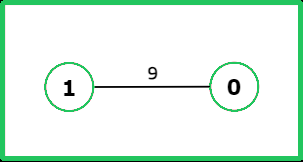
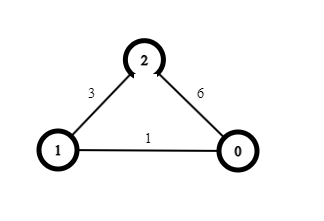


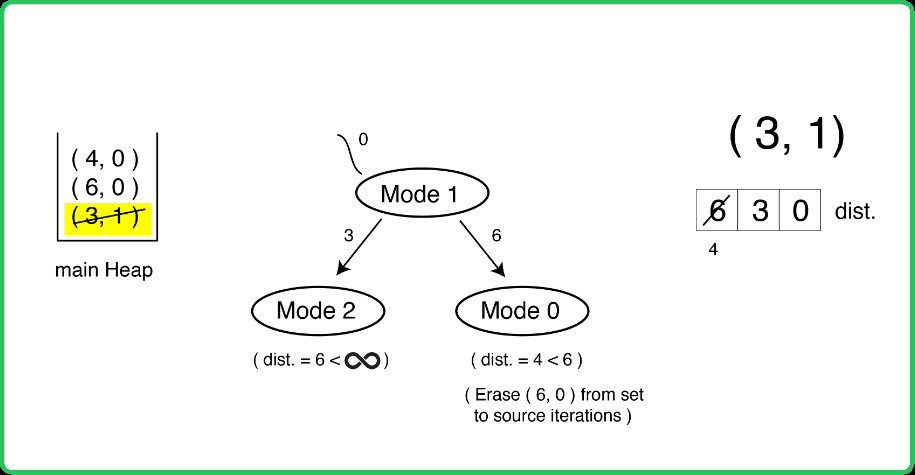
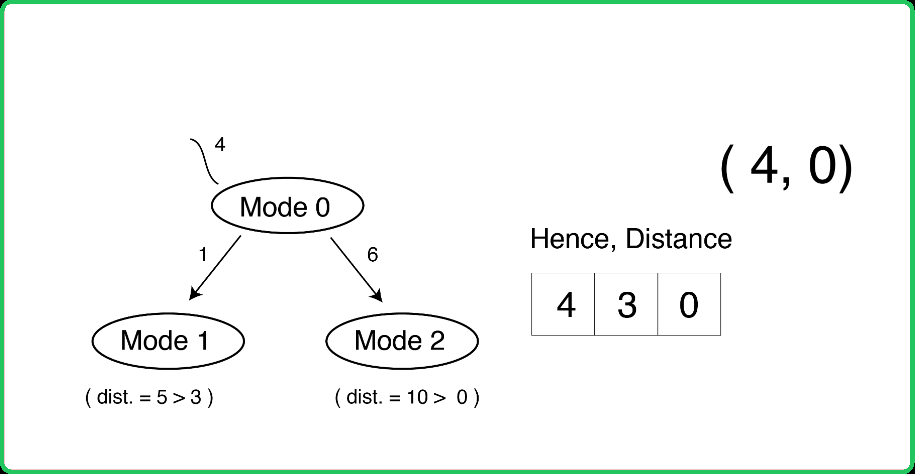
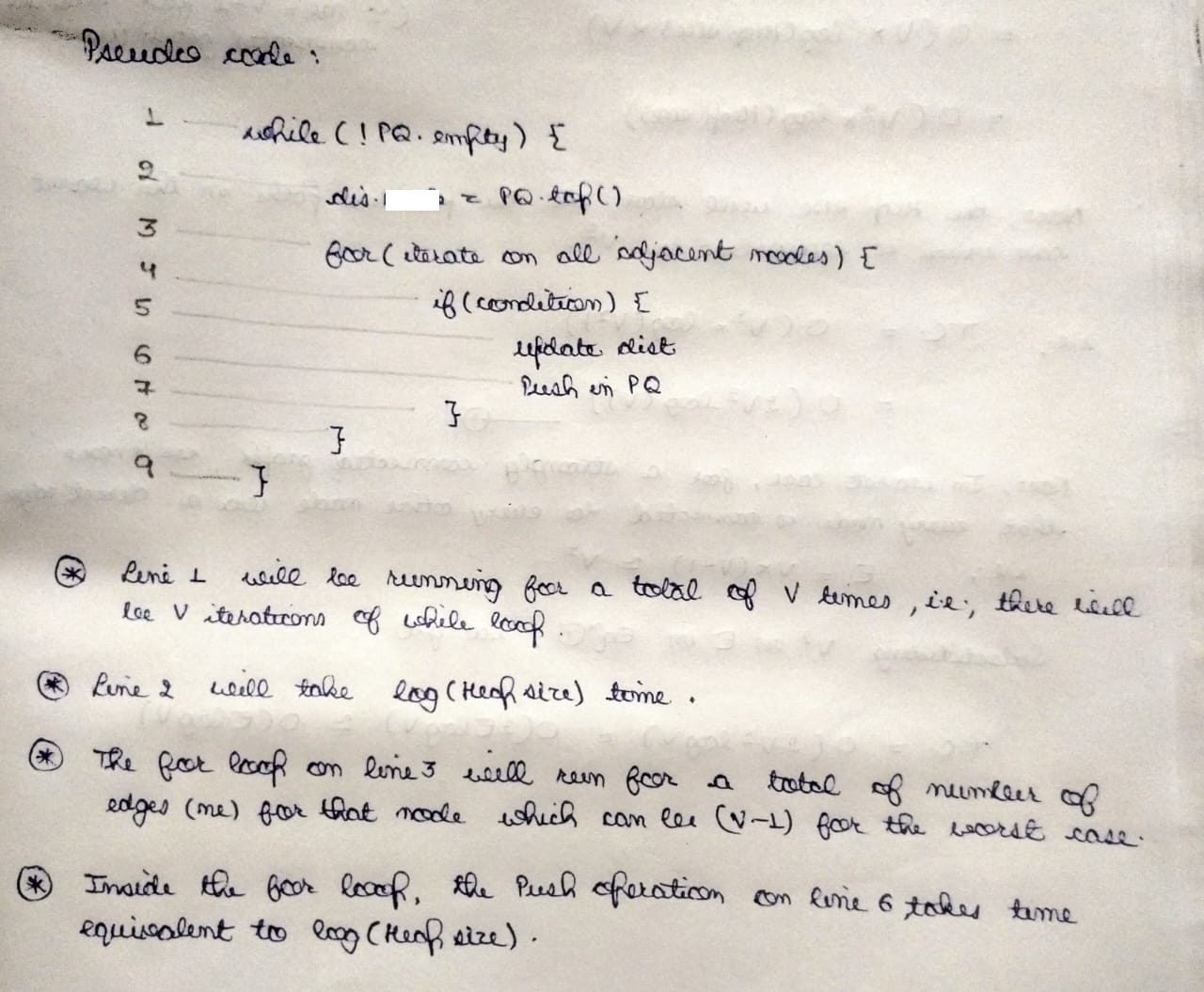
 ---!>
---!>